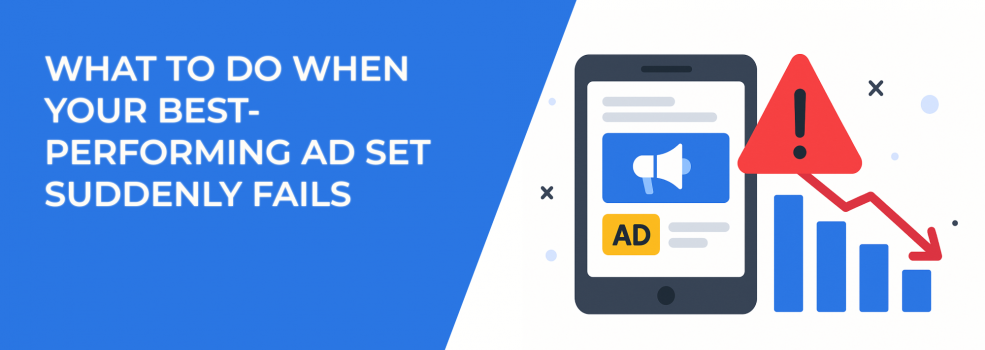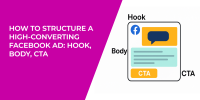It happens without warning.
One week, your best-performing ad set is delivering strong conversions at a cost per result you’d happily brag about. The next, the numbers slide downhill — clicks disappear, costs creep up, and you find yourself refreshing Ads Manager like it’s going to give you a different answer.
Before you make drastic changes, take a breath. Even the most successful ad sets are not immune to sudden shifts. Performance drops are usually a symptom, not the problem itself. The key is to figure out why it happened and which lever to pull first.
Below are both the common culprits and the less obvious pitfalls that can silently erode your results — and exactly how to tackle each one.
1. Rule Out Short-Term Fluctuations
The first mistake many advertisers make? Overreacting too soon. Digital ad performance is rarely a straight line; it’s a series of peaks and dips shaped by auction competition, user behavior patterns, and external factors you can’t control.
Instead of rushing to change everything after a single bad day, step back and look at broader trends. Use a longer date range to see if what you’re experiencing is just normal volatility.
What to do:
-
Review the past 7–14 days instead of just 24 hours.
-
Compare key metrics — CPM, CTR, conversion rate — to your historical averages.
-
Check for external timing factors like weekends, holidays, or industry events.
If numbers bounce back within a few days, you’ve saved yourself from unnecessary changes that could have disrupted a stable campaign. If they don’t, move to the next checks.
2. Watch for Audience Fatigue
If you’re starting to notice a steady decline in clicks and engagement, it could be more than just bad timing — you might be dealing with ad fatigue, which can quietly drain your campaign performance.
You can spot this in your reports long before it completely tanks performance.
Signs of fatigue:
-
Frequency creeping up — If your audience has seen the ad 3–4 times in a short window, the excitement fades.
-
CTR in decline — Even with the same reach, fewer people click.
-
Engagement drying up — Likes, comments, and shares slow down despite the same spend.
How to fix it:
-
Refresh your creative. Even small changes — a new image, headline, or hook — can re-engage the audience.
-
Widen your audience slightly to bring in fresh eyes, while still keeping targeting relevant.
-
Rotate multiple ads in and out so no single piece of creative gets overexposed.
Think of your audience like any social circle: overstay your welcome, and they tune you out.
3. Check for Targeting or Algorithm Changes
Meta’s ad delivery system is constantly evolving. Targeting categories disappear, new audience options emerge, and sometimes the algorithm decides to prioritize different delivery methods than before.
If your best ad set was built around an audience definition that’s now outdated or restricted, results can collapse almost overnight.
Action steps:
-
Audit your targeting to see if any of your interests, behaviors, or demographics were removed or merged.
-
Keep an eye on Meta’s official business updates — even small policy changes can impact delivery.
-
If your targeting is very narrow, test a broader audience or try Advantage+ targeting to give the algorithm more flexibility.
You don’t have to abandon what worked — but you might need to let the system adapt with more room to maneuver.
To keep your campaigns future-proof, it’s worth reviewing the latest Facebook Ads targeting updates and adjusting your audience strategy accordingly.
4. Audit Your Funnel Beyond the Ad
It’s easy to assume that if performance drops, the problem lies inside Ads Manager. But often, the issue is downstream — in the landing page, checkout process, or lead form.
If clicks are steady but conversions fall, the ad isn’t necessarily failing. It’s the user experience after the click that’s breaking the chain.
Things to review:
-
Page load speed — Anything above three seconds can kill conversions, especially on mobile.
-
Mobile optimization — Most Facebook traffic is mobile. Test on multiple devices to catch formatting glitches.
-
Message match — If your ad promises one thing but the landing page headline shifts the focus, users lose trust.
Your ad is only the first handshake. If the follow-through is weak, the deal falls apart.
5. Consider Market or Competitor Shifts
The Facebook auction is a living, breathing marketplace. A single aggressive competitor entering your space can push CPMs higher and eat into your impression share. Seasonal shifts in consumer behavior can also reduce response rates.
This isn’t about “bad ads” — it’s about a tougher environment.
What you can do:
-
Use Facebook’s Ad Library to see if new players have launched similar campaigns.
-
Adjust your bid strategy or daily budget to stay competitive in the auction.
-
Experiment with new angles or offers that differentiate you in a crowded feed.
It’s like running a shop on a busy street — when another store opens next door, you have to up your game.
When CPMs spike or click-through rates drop unexpectedly, it’s smart to check the Facebook Ad Library and see what your competitors are running — a sudden increase in similar offers could be influencing your results.
6. Test a Reset Without Losing Data
Sometimes an ad set’s delivery simply gets “stuck.” Maybe the algorithm found an early performance pattern it can’t shake, or past results are influencing current delivery in unhelpful ways.
You can break that cycle by duplicating the ad set — essentially hitting reset without starting from scratch.
Tips for a clean restart:
-
Duplicate the ad set and keep budget, targeting, and creative the same for the first few days.
-
Let the fresh version run for 3–5 days before making adjustments.
-
Compare the new performance directly to the old ad set’s numbers.
It’s not magic, but it’s often enough to shake the algorithm into finding fresh momentum.
If your ad set seems stuck in a low-delivery loop, you might need to reset it without scrapping your setup. Knowing how to finish the Facebook learning phase quickly can help you get performance back on track faster.
7. Check Hidden Budget Competition in Your Own Account
Many advertisers unknowingly compete with themselves. If multiple campaigns target overlapping audiences, they can bid against each other, driving up your CPM and limiting delivery.
This kind of “budget cannibalization” is invisible unless you know where to look.
Fix it by:
-
Using the Audience Overlap tool in Ads Manager.
-
Pausing or separating campaigns with high overlap.
-
Consolidating similar ad sets to give the algorithm more budget power.
Fewer, stronger ad sets often outperform many smaller ones fighting for the same audience. If you’re not sure how much this overlap is affecting you, this breakdown of audience overlap in Facebook ads explains how to measure and fix it.
8. Look for Attribution Window Mismatches
Sometimes, your ad set hasn’t truly failed — it’s just that you’ve changed how you’re measuring results. Switching from a 7-day click attribution to a 1-day click window can make conversions appear to drop even if sales are still happening.
How to handle it:
-
Compare data across different attribution windows to see the real story.
-
Keep attribution settings consistent whenever possible.
-
Use other tracking tools or analytics platforms to cross-check.
This prevents you from killing a good ad set based on misleading reporting.
9. Spot Delivery Throttling from Automated Rules
Automated rules are great for controlling costs, but they can also cut off a high-performing ad set before it has time to recover.
If your rules pause ads or slash budgets at the first sign of cost increases, you could be sabotaging delivery.
What to check:
-
Review all automated rules in Ads Manager for overly strict conditions.
-
Loosen the thresholds so you allow short-term fluctuations.
-
Temporarily disable rules while testing recovery tactics.
Sometimes the “safety net” is the very thing slowing you down.
Automated rules are powerful, but they can also kill delivery if set too aggressively. Learning how to use Facebook’s automated rules effectively will help you avoid unintentional throttling.
10. Audit for Disapproved Elements You Might Not Notice
Meta’s approval system can quietly limit where your ads run. Even if your ad isn’t fully disapproved, individual elements — a headline, certain words, or an image — might be restricted in certain placements. This limits reach without obvious warnings.
How to spot it:
-
Use “Ad Preview” to check how your ad appears in each placement.
-
Review delivery reports broken down by placement to see if some are missing.
-
Replace or adjust flagged elements to restore full distribution.
Think of it like a highway with blocked lanes — you might still be moving, but not at full speed.
Final Thoughts
When your best-performing ad set suddenly fails, it’s rarely because of one big mistake. More often, it’s a mix of small issues — a tired audience here, a landing page delay there, or a quiet shift in competition — that build up until the results slip.
The fix starts with a calm, methodical approach:
-
Assess before acting — check longer-term data so you’re not reacting to a random dip.
-
Identify the likely cause — is it audience fatigue, a funnel bottleneck, or a targeting change?
-
Tackle one variable at a time — make a single change, then monitor for a few days before moving to the next.
-
Document every adjustment — so you can track which changes help and which don’t.
-
Set a regular check-in schedule — even for your top performers, so you catch issues early.
Treat sudden performance drops as diagnostics rather than disasters. The faster you isolate the cause and implement targeted fixes, the faster you can restore — and sometimes even improve — your results.

